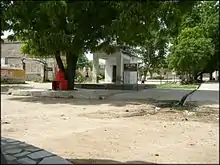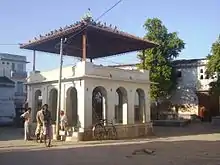Bamnera
Bamnera is a village situated in Sumerpur tehsil of Pali District in the state of Rajasthan, on Beawar-Radhanpur NH 14. The nearest railway station is Jawai Bandh.
Bamnera | |
|---|---|
village | |
 Bamnera Location in Rajasthan, India  Bamnera Bamnera (India) | |
| Coordinates: 25.17°N 72.96°E | |
| Country | India |
| State | Rajasthan |
| District | Pali |
| Government | |
| • Body | Gram Panchayat |
| Area | |
| • Total | 3.1 km2 (1.2 sq mi) |
| Elevation | 221 m (725 ft) |
| Population (2011) | |
| • Total | 732 |
| • Density | 240/km2 (610/sq mi) |
| Languages | |
| • Official | Marwari, Hindi |
| Time zone | UTC+5:30 (IST) |
| PIN | 306901 |
| Telephone code | 02933 |
| ISO 3166 code | RJ-IN |
| Lok Sabha constituency | Pali (Lok Sabha constituency) |
| Vidhan Sabha constituency | Sumerpur |
| Civic agency | Gram Panchayat |
| Avg. annual temperature | 30 °C (86 °F) |
| Avg. summer temperature | 44 °C (111 °F) |
| Avg. winter temperature | 05 °C (41 °F) |
Bamnera is located on the Brahmi River, at the foot of Dhavalgiri hill, locally pronounced as Bhakri (भाकरि). Bamnera is 23 km away from the Western Railway station at Jawai Bandh, earlier known as the Erinpura Road. En route to Bamnera from Sheoganj, the road crosses the Sukri River. This intersection is called Fufaat. During monsoons, seasonal rains overflow its banks with a forceful current, and hence it is called Fufaat (Forceful). A concrete bridge called Pakki Rapat is constructed on this river.
Etymology
The name Bamnera is derived from the Marwari word 'Boman' and 'Dera' i.e. 'Bramhanera'. The word 'Boman' is derived from the Sanskrit/Hindi word Brahman and in English it is spell as Brahmin. Brahmin is one of the upper caste in Hindu religion. The village is dominated by Audichya Gorwal Brahmins. 'Dera' in Hindi means base or camp. The Brahmin families migrated and settled down permanently hence, it is called 'Bramhanera' i.e. 'Bamnera'.
Climate and rainfall

Climate is somewhat different from that of other villages in western Rajasthan. In the summer season, temperatures can reach up to 46-47 degrees Celsius at peaks in May–June, but with much variation in temperature, due to adjoining green and hilly areas. Winters are moderately cool (in December–January), when the temperature dips to 4-5 degrees Celsius occasionally. Average rainfall in July–October is 300 mm. [1]
History
In ancient 'Bramhanera' or Kollapur Paatan, an ancient civilization developed. The Archaeological Survey of India has excavated there extensively, to study the ancient civilization of Rajasthan. A copper plate found at a dig in Bamnera is kept in the Shri Bangar Government Museum, in Pali, in Pali District

An ancient Suryamandir renovated in samvat 1258 vikram era (according to Marwari calendar (मारवाड़ी मिती), attests to its ancient history. The village is dominated by a Gorwal Audichya Brahman community along with other castes such as Rajpurohit, Meenas, Suthars, Kumbhars, Rajputs, Harijans and Saads. [2]

Demography
Bamnera is a medium size village located in Sumerpur in Pali district, Rajasthan with, total, 203 resident households. Bamnera has a population of 732 of which 361 are males while 371 are females as per Population Census 2011.
In Bamnera village the population of children age 0-6 is 72 which makes up 9.84% of the total population of the village.
Bamnera village has higher literacy rate than most of Rajasthan. In 2011, literacy rate of Bamnera was 66.97% compared to 66.11% for Rajasthan as a whole. Male literacy stands at 80.19% while female literacy rate was 54.30%.
Bamnera has a substantial population of Scheduled Caste. Schedule Caste (SC) constitutes 26.64% while Schedule Tribe (ST) were 16.67% of the total population in Bamnera.
Of total population, 235 were engaged in work activities. 73.19% of workers describe their work as Main Work (Employment or Earning more than 6 Months) while 26.81% were involved in Marginal activity providing livelihood for less than 6 months. Of 235 workers engaged in Main Work, 25 were cultivators (owner or co-owner) while 4 were Agricultural labourer.
As per constitution of India and Panchyati Raaj Act, Bamnera village is administrated by Sarpanch (Head of Village) who is elected representative of village.[3]
| Particulars | Total | Male | Female |
|---|---|---|---|
| Total Houses | 203 | ||
| Polulations | 732 | 361 | 371 |
| Child (0-6) | 72 | 38 | 34 |
| Schedule Caste | 195 | 101 | 94 |
| Schedule Tribe | 122 | 66 | 56 |
| Literacy | 66.97% | 80.19% | 54.30% |
| Total Workers | 235 | 184 | 51 |
| Main Worker | 172 | 0 | 0 |
| Main Worker | 63 | 25 | 38 |

Temples
In eastern side of Bamnera, there is a small hill, known as 'Tarwadio Ki Magri', but popularly known as 'Khimel Bhakri'. There are few auspicious temples in Bamnera are as mentioned below:
- Charbhujaji Mandir
- Kedareshwar Mahadev Temple
- Wagheswer Mahadev Temple
- Khimel Mata Temple
- Bhevmata Temple
- Pimpleshwar Temple
- Umiya Mata Temple
- Ramdevpir Temple
- Suryadev Temple
- Shri Korthaji tirth Jain Temple or Shri Korta Tirth Jain Mandir
- Varvesimata Temple
- Chamunda Mata Temple
- Shri Brahmani Mata Mandir (Kadarvavi)
- Shri Aapeshwar Mahadev Temple (Vanvavri)
Monuments, Temples and Public Places in Bamnera and their Functions:
Shamalaji / Charbhuja Temple (Dehra) : It is situated in the middle of Bamnera village and in the heart of every Bamneraites.
Shri kedareshwar Mahadev Temple: This is a bigHoly temple, though, not under the territory of Bamnera, but still, it is one of the important holy place for any local functions.
Shri Pimpleshwar Temple: It is situated on the bank of Brahmi ('Sukadi' river) originated from Gautameshwar.
Shri Wagheshwar Temple: It is located on the bank of Jawai river.
Shri Aapeshwar and Koteshwar Temple: These temples are buried in the ground. They are under the restricted area of archaeological Survey of India.
Amenities

Pechka (Peska): This is one of the oldest resource for drinking water for many years. It is situated in the middle of 'Brahmi' river ('Sukadi'). Now, we have water supply facilities provided by Rajasthan Water Supply Department. Presently, its water is used for cattle and other purpose.
Mithibai Rupalal Navalramji Charitable Trust: This trust had built a hospital cum Primary Health/Medical center, which was inaugurated by Ex- Chief Minister, Shri Haridev Joshi.
Bhuralal Dungaji Secondary School: This school by Durgashanker Daulatramji Kevalramji along with other people. The school has pre-primary std 1 to std 10 class and have a huge ground for sports.
Nohra (Nuru): Nohra is a place within any village, equipped with all the facilities required for catering, cooking and eating arrangements. Bamnera has a huge 'Nohra' but still require a renovation and better seating arrangement. We have one more 'Nohra'. Even though comparatively small in size, but still useful in small ceremony like Yagnopavit and marriages.
Gaushala: Gaushala is managed by Shri. Bamnera Gaurakshak Charitable Trust. Normally, this Trust is headed by active Sarpanch.
Shri Bamnera Jankalyan Mandal: Shri Bamnera Vidhtya Prakashan Mandal and Shri Bamnera Jankalyan Mandal is effectively and efficiently working in the village as well as in Mumbai.
 Bamnera Vidyalaya
Bamnera Vidyalaya Bamnera Vidyalaya
Bamnera Vidyalaya Pechka
Pechka Bamnera School
Bamnera School
Cuisine
Cuisine is predominantly vegetarian and dazzling in its variety. Food is cooked with minimum use of water and people prefer to use more milk, buttermilk and clarified butter. Dried lentils, beans from indigenous plants like sangri and ker are used liberally. Gram flour is major ingredient here and is used to make some of the delicacies like Kachori, bhajiya, gatte ki sabji, pakodi, powdered lentils are used for papad. Bajra and corn is used majorly for preparations of traditional mouthwatering (drooling) dishes. People are also fond of Raabdi, khichdi, dal-dhokdi and rotis like makki ri ghat and bajra ra hogra. Various chutneys are made from locally available spices like turmeric, coriander, mint and garlic.
The spice content is on the higher side, even by Indian standards. The most famous dish would probably be dal-bati, which are spicy lentils with baked balls of wheat with much ghee. The variety of sweet dishes is also immense and sweets are relished as much as the spicy curries. Some of the popular sweet dishes are Daadi ru Hiru, vasaniyu, mootichur, boondi and Kharmoo ra Ladoo, Sutarfini. "Athithi Devo Bhava", inhabitants believe in that and as the old Sanskrit saying goes, guests are fed with affection, also termed manuhar or manvar. It is considered rude to just lay the food on the table and expect guests to serve themselves.
Sweet dishes are never referred to as 'dessert', because unlike desserts which are had after the meal, over here sweets are had before the meal, with the meal, and after the meal! And typically there is no rationing. Dal Batti - Churma is the most popular delicacy usually served with baatis and dal. It is coarsely ground wheat crushed and cooked with ghee and sugar. Traditionally it is made by mashing up wheat flour baatis or left over rotis in ghee and jaggery.
Music and entertainment
Folk songs are sung by women during marriages and other social occasions. Many villagers own TVs and Radios. One can hear sounds of popular native songs (in the form of bhajans) and Hindi music emanating from stereos and other devices during evenings and afternoons from different houses.
Games and sports
Most of the children play cricket / Gilli Danda / Marbles. Some villagers also play volleyball and football. Villagers can be seen playing cards at the premises of pimpleshwar mahadev mandir. Some children play tass patti of match box.
Festivals
Villagers celebrate all major Hindu festivals. Some of the major festivals are Holi, Deepawali, Makar Shakranti, Raksha Bandhan, Teez, etc. Villagers celebrate holi/Dhuleti for 15 days. It is quite a carnival for them. Most of the people perform gher dadan at SOTARA. Usually people spend the day throwing coloured powder and water at each other. Also a special drink called thandai is prepared, sometimes containing bhang (Cannabis sativa). People invite each other to their houses for feasts and celebrations later in the evening. Unlike others who use more long-lasting and strong colors (which are chemically enhanced and artificial colors). Villagers prefer to use coloured powders which has a medicinal significance and are traditionally made like out of Neem, Kumkum, Haldi, Bilva, and other medicinal herbs.
Economics
The main occupations of the people in the Bamnera are agriculture, pashupalan and yajamaanvrutti. Like other village, many local people had migrated from Bamnera to different regions of Maharashtra, Madhya Pradesh and Gujarat in search of better opportunity. Still, local people are engaged in agriculture, teaching and Yajamaanvrutti. Some people have also excelled in the field of engineering, medical, banking, computers and IT Technologies. There are several people located in foreign countries as well.
How to reach Bamnera
- By Air: Nearest Airport is Jodhpur or later on Udaipur.
- By Train: The nearest railway station is Jawai Bandh which is approximately 25 km. away from Bamnera.
- By Road: Rajasthan bus transport services is available from Ahmedabad to reach Bamnera or nearest getting down point is Sheoganj.
Nearby Cities and Towns
- East : Sheoganj (12 km), Sumerpur (15 km).
- North : Takhatgarh(30 km).
- West : Jalore District.
- South : Sirohi (50 km).
 Nohra
Nohra Bamnera village
Bamnera village Sri Kedareshwar Mahadev
Sri Kedareshwar Mahadev